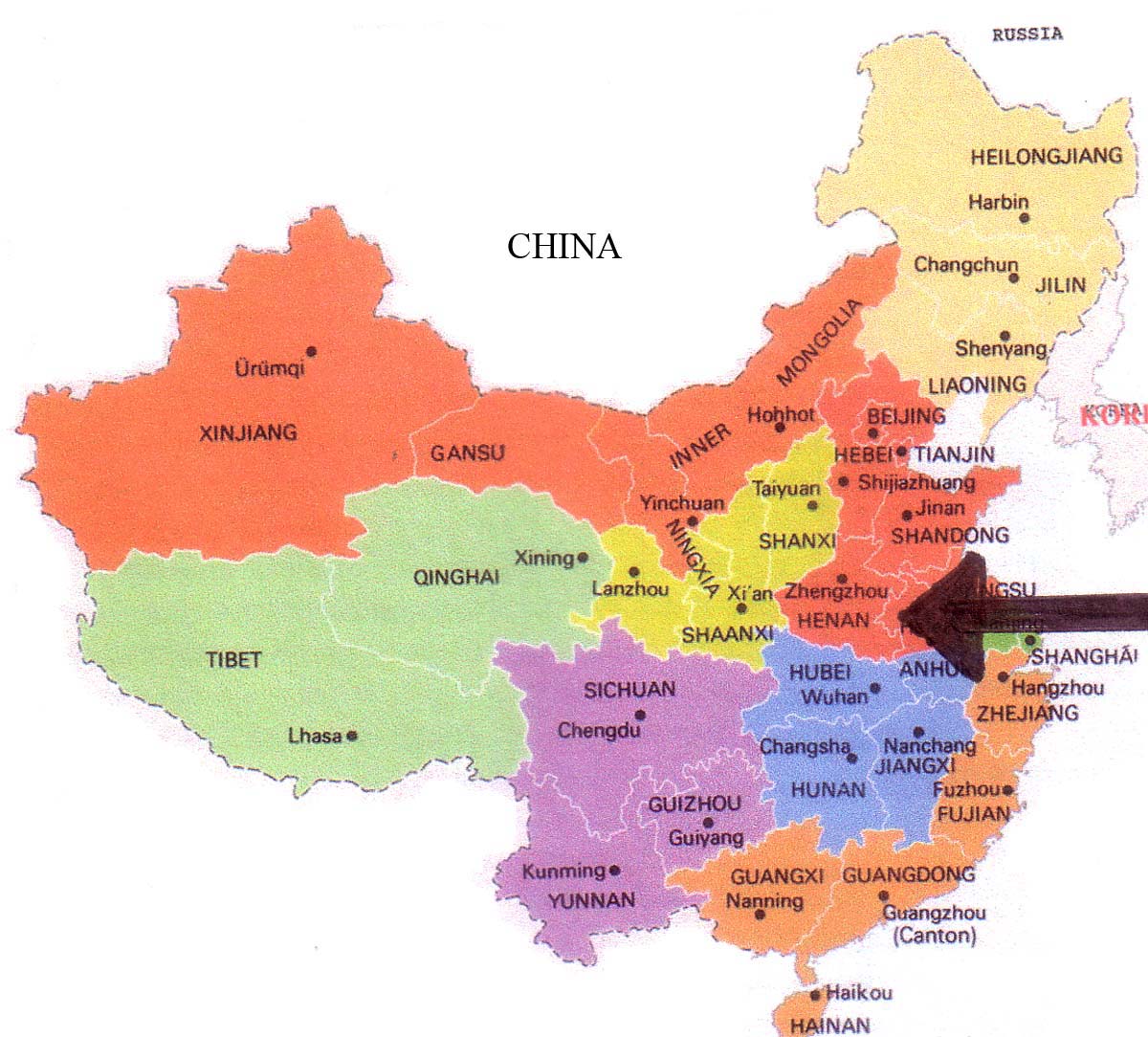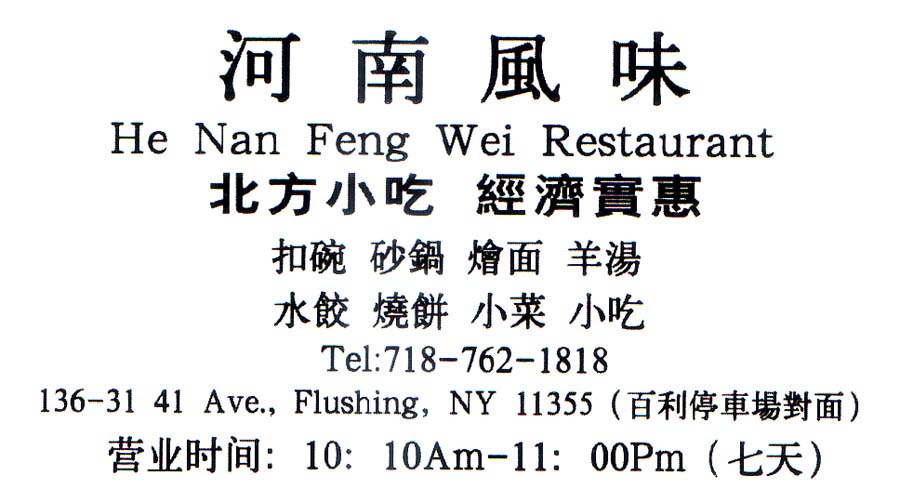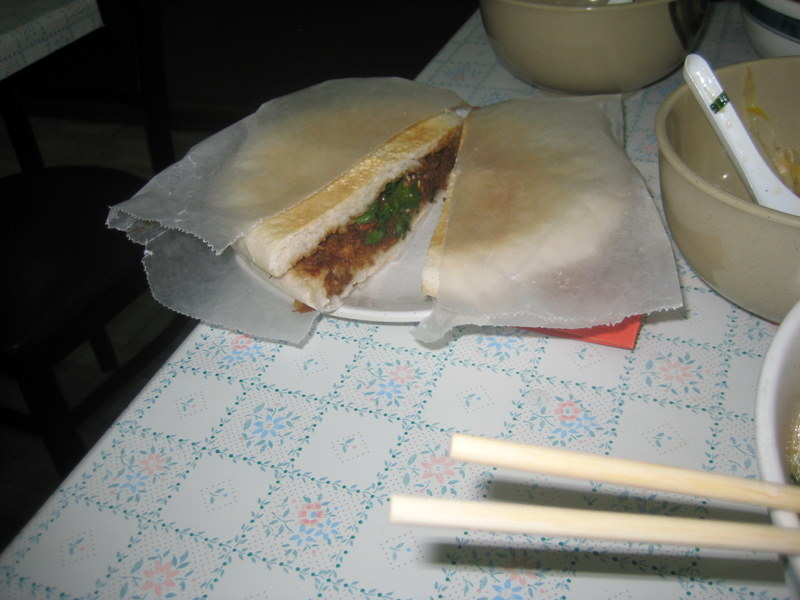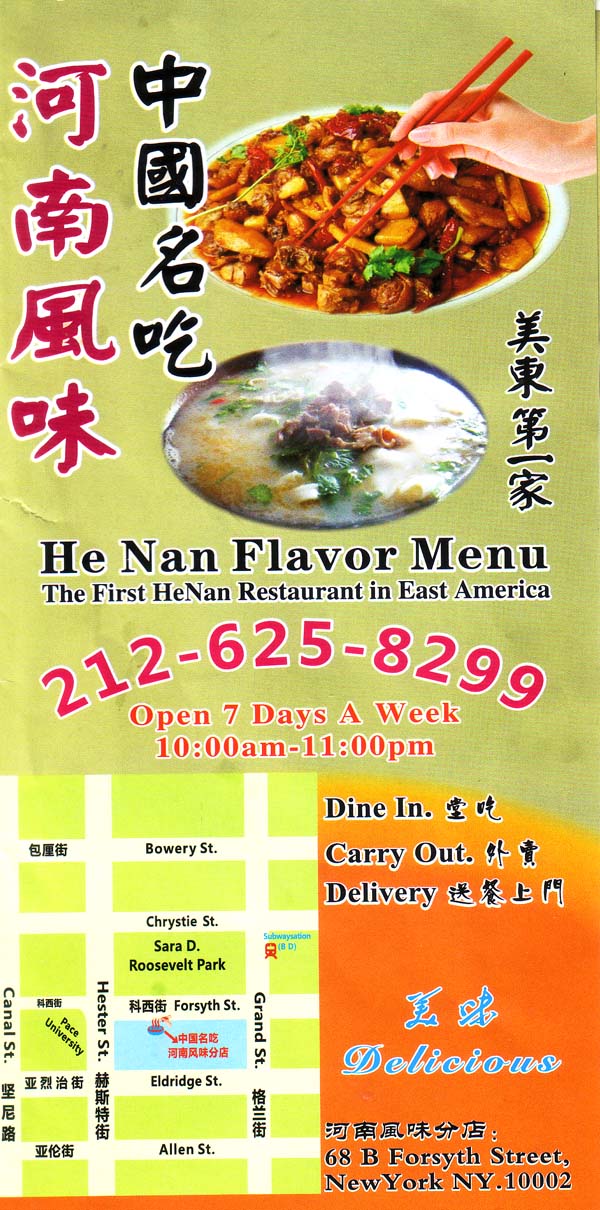
| What is Flavor and Fortune? |
| How do I subscribe? |
| How do I get past issues? |
| How do I advertise? |
| How do I contact the editor? |
Read 13184713 times
Connect me to:
| Home |
| Articles |
| Book reviews |
| Letters to the Editor |
| Newmans News and Notes |
| Recipes |
| Restaurant reviews |
| Article Index (all years, slow) |
| List of Article Years |
| Article Index (2026) |
| Article Index (last 2 years) |
| Things others say |
| Related Links |
| Log In... |
| Authors |
| Categories & Topics |
Henan and Its Foods
| by Jacqueline M. Newman |
Regional Foods
Winter Volume: 2011 Issue: 18(4) page(s): 12, 13, and 19
 The province of Henan, also written He Nan, has the largest provincial population in China. Physically, a mite smaller than the state of Wisconsin, this province has about one hundred million while, for comparison's sake, Wisconsin has less than six million people.
The province of Henan, also written He Nan, has the largest provincial population in China. Physically, a mite smaller than the state of Wisconsin, this province has about one hundred million while, for comparison's sake, Wisconsin has less than six million people.
Henan is known as the 'cradle of Chinese civilization' but not because it borders on so many provinces. Hebei is to the north, Shandong to the northeast, Shanxi to the northwest, Anhui to the southeast, Hubei to the south, and Shaanxi to the west. Located in the middle to lower reaches of the Yellow River, the name Henan means 'South River.' With many small rivers flowing in to the middle to lower reaches of China's immense Yellow River, Henan is in the area where many believe the Chinese people originated, hence the nomencalture of China's cradle.
 Rich in coal, gold, and aluminum, finall a Henan restaurant in the USA, though it has been inhabited at least since 12,000 BCE when Neolithic societies lived here. Recently, records and artifacts dating back almost that far have been found, many located in what may be the largest Shang Dynasty archeological site in China.
Rich in coal, gold, and aluminum, finall a Henan restaurant in the USA, though it has been inhabited at least since 12,000 BCE when Neolithic societies lived here. Recently, records and artifacts dating back almost that far have been found, many located in what may be the largest Shang Dynasty archeological site in China.
This very populated province boasts good soil, much from silt washed over it by the Yellow River during its many floods. This has allowed growth of lots of sesame seeds for oil and for eating, and more wheat than most provinces produce. This may explain why many call Henan one of China's great bread-basket regions. Though it does grow tons of wheat, rice is the staple grain in this province, and folks here like it prepared with oil rendered from animal fat. There is no shortage of that either as they raise many animals in this province.
The diet in Henan is based on Han foods created with earlier items eaten during the Shang Dynasty (circa 16th - 11th centuries BCE). Foods here became very popular during the Northern Song Dynasty (960 CE - 1127 CE) and are popular to this day. They are loved by the ninety-eight percent of their population who are Han; and in addition to them, some minorities do live here. The largest are the Hui people who practice their Islamic faith, and some Salar people who do likewise. Among the Han, Buddhism was and is an important force. Near Luoyang is the Shaolin Monastery, near Louyang are the Buddhist Longmen Caves and the Baima Temple, and in Kaifeng the Da Xiang Guo Buddhist Temple
 Foods in Henan tend to be salty and prepared with lots of onions. They are also prepared thinking of their seasonality. Pork is the main meat, lamb popular in soups. Noodles and breads are cooked with both meats and with many vegetables. In the capital city of Zengzhou, the eight plus million people living here love stewed noodles and sandwiched as seen here.
Foods in Henan tend to be salty and prepared with lots of onions. They are also prepared thinking of their seasonality. Pork is the main meat, lamb popular in soups. Noodles and breads are cooked with both meats and with many vegetables. In the capital city of Zengzhou, the eight plus million people living here love stewed noodles and sandwiched as seen here.
In the city of Luoyan, a favorite dish is Peony and Swallow Vegetables. Several kinds of noodles are served at their well-known Water Banquet meals. In the city of Kaifeng, steamed stuffed buns are thought tops, as is chicken made in salt, also mashed sweet potatoes. One unusual dish is the province's fish topped with noodles; a pictured shows this dish. In the city of Anyang, they love sweets and make theirs with flour, eggs, and lard.
The cuisine in Henan is said to be a cross between foods of Jiangsu and Beijing mixed with those of other neighboring provinces; many have origins in and near Kaifeng. Some are called Xinyang Duncai, others Luoyang Shuixi, and still others spoken of simply as 'local soup cuisine.' Many dishes in this province have the names of the cities where they were made popular. Different soups are made with hand-stretched, also called hand-pulled, wheat or rice noodles.
 In the past, China's capital city was located in one or another city in this province. For example, during the Song Dynasty (1766 - 1122 BCE), it was in Anyang, during Eastern Zhou times (770 - 221 BCE) it was in Louyang, and during several dynastic periods including the Five Dynasties (907 - 960 CE), Northern Song Dynasty (960 - 1126 CE), and the Jin Dynasty (1126 - 1334 CE), it was in Kaifeng. These cities are still important, as are those of Xinxiang, Xuchang, and Luohe; they are simply no longer the capital of the province.
In the past, China's capital city was located in one or another city in this province. For example, during the Song Dynasty (1766 - 1122 BCE), it was in Anyang, during Eastern Zhou times (770 - 221 BCE) it was in Louyang, and during several dynastic periods including the Five Dynasties (907 - 960 CE), Northern Song Dynasty (960 - 1126 CE), and the Jin Dynasty (1126 - 1334 CE), it was in Kaifeng. These cities are still important, as are those of Xinxiang, Xuchang, and Luohe; they are simply no longer the capital of the province.
In Henan, one of the most famous provincial dishes is Daokou Braised Chicken. First made in the town of that name and appreciated by Emperor Jiaqing, this red-cooked bird is spoken of by some as the best cooked chicken in the entire country. Another well-known and popular dish is Four Delicacies. This stewed/braised dish from Kaifeng first made its appearance during the Qing Dynasty, and it is also known as Four Treasure Wrap or the Four-bird Delight. From inside to out, one finds a pigeon in a quail, both of these inside a chicken, and all three stuffed into a duck. One source says this multi-layered poultry dish was first prepared for Empress Cixi near the end of the Qing Dynasty. Not everyone agrees, but what is agreed upon is that Chen Yongxiang or someone in his family was the first to prepare it.
There are many other famous Henan dishes including a thousand-layer stewed cake called Ge, streaky pork and greens in a soup, and a Kaifeng delight made with carp and noodles prepared and served with a sweet and sour sauce. This last dish is unique. It fries the fish, then puts noodles on top, and finishes it off, baking or steaming them together.
Another local dish is Steamed Ribs with Bamboo Shoots. To prepare it, one boils then steams the ribs, then stir-fries them with cut-up vegetables. Besides these and the items previously mentioned, other famous dishes include Sweet and Sour Carp, Cucumber Shaped as a Lotus Flower, Jadeite Balls, Jadeite Shredded Fish, and Fried Purple Pork.
When in Henan's current capital city, one should go to the National Museum to see it; it is one of China's oldest and largest and is on Nongye Road near many fine restaurants. When in Kaifeng, eat up a storm at the Gulou Night Market. Not able to get to there, read Michael Gray's review of the first, and that of the only Henan restaurant in the United States. It was published in Volume 18(2) on page 22, and also know the owner recently opened a smaller eatery in Manhattan at 68B Forsyth Street. The first page of its menu is shown on this page. His first place is in Flushing with a below street level entry way. it is shown on this page, too, and is getting more popular every day. Go to either of them and try the many soups and other foods available from this province. If getting to either or both is not possible now, try the recipes below. But if you can get to one of them, try the pancake sandwich at either one. it is on the cover of this issue, and is the best fast food bargain in New York City. it costs but two bucks, you will be delighted with that purchase.
| Braised Chicken, Henan Style |
|---|
1/2 pound chicken breast, its meat left on the bone 1 teaspoon coarse salt 1 whole egg, beaten until light in color 3 Tablespoons cornstarch 1 large Chinese yam, peeled, about half a pound 1 cup vegetable oil 1 Tablespoon thin soy sauce 2 scallions, cut into one-inch pieces 1 Tablespoon thinly sliced fresh ginger 1 teaspoon granulated sugar 2 whole star anise 2 Tablespoons Chinese rice wine Preparation: 1. Chop chicken breast into two-inch cubes, then mix them with the salt, beaten egg, and cornstarch; and let them rest for half an hour. 2. Cut yam into same size pieces as the chicken. 3. Heat oil in a wok and deep fry the chicken pieces, remove them when crisp to a clay pot or a ceramic casserole. 4. Reheat the oil and fry the yam cubes until golden, then drain them and put them on top of the chicken pieces. Discard the oil or save it for another use. 5. Mix soy sauce, scallions, slices of ginger, the sugar, star anise, and the rice wine, and pour this into a cleaned wok and bring to the boil, reduce heat and simmer for five minutes before pouring this over the chicken and the yam pieces. Cover the claypot, and steam for twenty minutes over rapidly boiling water. 6. Carefully invert the solids in the claypot to a deep-sided platter, remove and discard the star anise, then pour the remaining liquid over the chicken-yam mixture, and serve. |
| Carp and Cucumber |
|---|
1 whole carp, about two pounds, scales removed, the fish gutted and rinsed, and the head and tail removed and set aside 2 Tablespoons Chinese rice wine 1/4 teaspoon coarse salt 2 large cucumbers 1/2 cup cornstarch 2 egg whites 1 cup vegetable oil 1 Tablespoon minced red onion 1 teaspoon minced fresh ginger 1/4 cup granulated sugar 1/4 cup Chinese rice vinegar 1/2 Tablespoon tomato paste 1/2 cup chicken broth Preparation: 1. Slice the fish lengthwise into one dozen pieces, each about quarter-inch thick by one inch by two inches. 2. Put these slices into a bowl with the rice wine and salt, mix very gently, then allow this to remain for half an hour, then drain the fish and set them on a platter. 3. Peel the cucumbers, cutting each slice of peel in half. Make twelve pieces of cucumber skin. Set each one on a slice of the fish, then roll them up together. 4. Mix the egg white and the cornstarch into a paste and dip the head, tail, and the fish rolls in this paste. 5. Heat the oil in a wok and deep fry the head, tail, and the fish rolls until they become golden yellow, then remove them and drain on paper towels. When drained well, put these on a platter head at one end, tail at the other, and the rolls in a double line between them. 6. In a clean wok or sauce pan, add one teaspoon of the remaining oil, stir-fry the onion and ginger for half minute, add the sugar, vinegar, tomato paste and the chicken broth and bring to the boil, then pour this over the fish, and serve. |
| Jadeite Balls |
|---|
1/2 pound fresh or frozen peas 1/2 cup granulated sugar 1/2 cup glutinous rice flour 1 teaspoon osmanthus flower, mashed or minced 1/2 cup Chinese red dates, pits removed and discarded, and mashed, and divided into twenty batches 1 cup lard Preparation: 1. In a steamer, steam the peas in a covered bowl over rapidly boiling water for half an hour. Remove and then mash them well. 2. Add the sugar, rice flour, and the osmanthus flower, and one to two tablespoons of boiling water. Remove from the bowl and knead, then roll this into a cigar-shaped piece. Next, cut it into twenty pieces and roll each into a small circle. 3. Put one mashed date piece into the center of each circle, and form this into a ball. 4. Heat lard, and fry the balls until crisp. Remove from the lard, and drain them on paper towels. Serve them n a pre-heated plate. |

Copyright © 1994-2026 by ISACC, all rights reserved
Address
3 Jefferson Ferry Drive
S. Setauket NY 11720